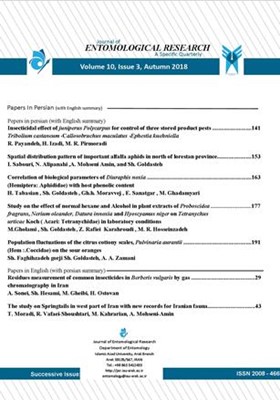Population fluctuations of the citrus cottony scales, Pulvinaria aurantii (Hem., Coccidae) on the sour oranges
Subject Areas : entomology and othea arthropods
Sh. Faghihzadeh Gorji
1
,
Shila Goldasteh
2
![]() ,
A. Zamani
3
,
A. Zamani
3
1 - Department of Entomology, Arak branch, Islamic azad university, Arak, Iran
2 - Department of Entomology, Arak branch, Islamic azad university, Arak, Iran
3 - گروه گیاهپزشکی، دانشکده کشاورزی، دانشگاه رازی، کرمانشاه، ایران
Keywords:
Abstract :
The sour oranges is a horticultural crop in Iran and planted as ornamental trees all over the world (except polar regions) such as the north of Iran. The citrus cottony scales Pulvinaria aurantii Ckll. feeds on the foliage and stems of citrus trees and cause tree dieback in heavy infestation. In order to estimate the seasonal population fluctuations in Babol (Mazandaran province, Iran), sampling were done at the height of 1.5 to 2.5 meter of citrus trees and samples were collected from four geographical directions and three points including initial, medial and apical 40 cm of the branches. Further information such as daily temperature, relative humidity, and the amount of rainfalls simultaneously were recorded in each sampling date. The maximum number of population was observed in the January of 2014. We found that this species completes four generations per year. Based on the results of this study the best time for managements of the 1st, 2nd, 3rd and 4th generation of P. aurantii Ckll. in Babol is May, September, and to spot spraying in November and December, respectively. Pruning can be usefull too. In this study, natural enemies’ minority were observed which may be related to the insecticide treatments, absence of intermediate host and also the environmental pollution. Our results could lead to improve integrated pest management for P. aurantii Ckll.populations in the north of Iran.
_||_


